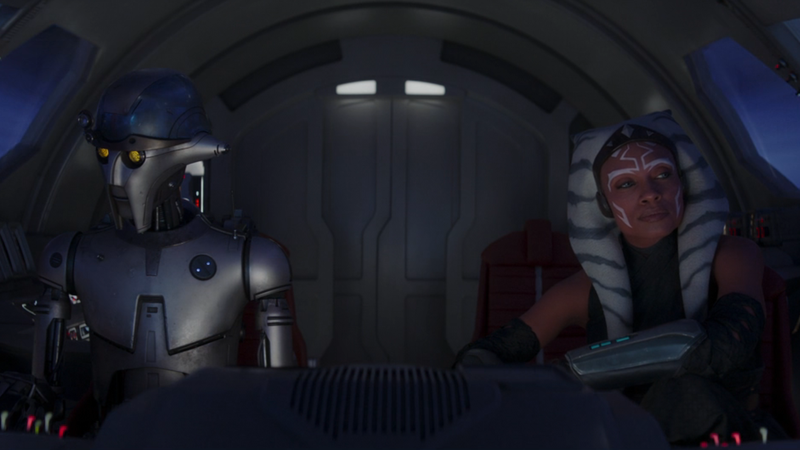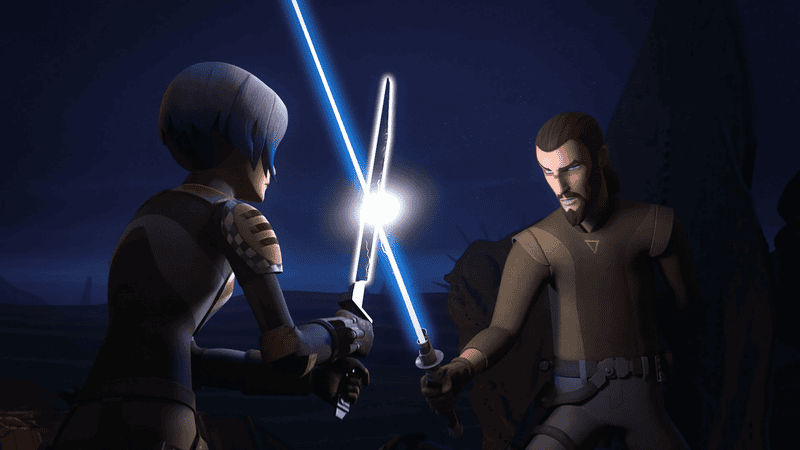In the run up to Disney+ series Ahsoka, there was a lot to be said about how the show will approach its titular protagonist’s relationship to the Jedi identity—what it means to be referred to as such outside of the confines of the Jedi Order, and what it can be as Star Wars more broadly looks to rebuilding that institution in its future. But now the show is here, it’s laying the groundwork for something with implications far beyond just Ahsoka herself.

Ahsoka’s third episode, “Time to Fly,” opens with a frustrated Sabine going through the lessons and reminders of the Jedi Order, ones that pushed her away from Ahsoka before the events of the series. No matter how hard she tries, no matter how much she re-commits, she is told that she’s just not good enough to be a Jedi. She can’t do the training the way Professor Huyang wants her to, she can’t even keep up with Ahsoka’s more gentle, but still pressing attempts to teach Sabine how to reach out and connect to the Force. Even as she’s mocked by a small cup she can’t bring herself to move with her mind, we cut to Huyang and Ahsoka discussing Sabine’s progress in the cockpit of their vessel, and Huyang—befitting of a character that has to embody the long history of the Jedi Order for its other heroes, both in terms of knowledge but crucially in attitude—just laying in to Sabine’s chances of completing her training.

She doesn’t have the Force sensitivity that the Jedi would’ve accepted, Huyang snips. She doesn’t have the standards, Huyang pointedly notes, only to fight back when Ahsoka, in a glimmer of her own nuanced history with the Order, pushes back that those standards got the Jedi nowhere but dead in the ground. His questioning of Sabine’s capacity even veers into a kind of bizarro borderline race science, as he haughtily notes to Ahsoka how few of those Mandalorians ever had what it took to be Jedi in the first place across thousands of years. It’s all a little bit horrifying, and a lot of Huyang being a bit of a dick, but that’s the point here. He’s meant to be the avatar not of Jedi, but the Jedi Order: all the rules and restrictions and judgements that institution placed on themselves and broadly on the Force itself, the rules in turn that we as Star Wars fans have come to place on who can and cannot be a Jedi. Which is only fair, because it’s by and large the only rules that Star Wars has presented us with when it comes to how the Force works.
But they no longer have to be, and slowly, but surely, Star Wars is indicating that they won’t. What Ahsoka pushes back with against Huyang’s recital of standards and doctrine—that she doesn’t need Sabine to be a Knight of the Jedi Order, she needs her to be Sabine, and that the best version of herself will come when she can put aside the frustrations and doubts Huyang helped put in her and open herself up—builds on what Star Wars has always said, even after the prequels’ introduction of midichlorians lead to the infuriating haves-and-have-nots debate of who’s allowed to use the Force. Sabine herself has even been part of that idea, when in Rebels—as she’s trained by Kanan and Ezra in the basics of lightsaber combat to wield the Darksaber—Kanan tells both us and Hera alike that the Force resides in all living beings, they just have to be taught how to open up to it. It’s this, just as Kanan did then, that Ahsoka wants Sabine to do—let the Force in, and see what understanding that connection can do for her, not for being a Jedi.

In doing so—and if Ahsoka eventually leads to a path where, in some form or another, Sabine manages to build on her connection to the Force and wield it in some capacity—we come one step closer to arguably the most Ahsoka Tano thing Ahsoka could do: democratize what Jedi means as a title beyond the confines of the Jedi Order as an institute. Anyone can be a Jedi in a world where the Force is open to and embraced by all, not by the number of special doohickeys in your blood. Anyone can be a Jedi in a world where a recalcitrant Order decides who does and doesn’t get to be no longer exists. The Force itself, and Star Wars’ interpretation of it, can be open to so many more other ideas and usages if we allow this concept to broaden beyond these so called “standards”—beyond perhaps even what Ahsoka suggests, where these new kinds of Jedi are much like the older ones, but with less shitty politics. Becoming a Jedi doesn’t have to be a strict set of rules, it can be, appropriately perhaps, a philosophical and spiritual ideal—a feeling people are drawn to, to better understand the world around them and their place within it. And what better a galaxy for the Force to re-awaken into, than one where anyone can become the idea of a Jedi, if they want to be?
The universality of what Star Wars can mean to people across generations has always been one of its greatest strengths—and as it looks beyond Ahsoka and to the future of a New Jedi Order largely unbeholden to the restraints of what came before, it has a chance to make that universality keenly felt in its portrayal of just who gets to be the kind of hero they want to be in its world.
Want more entertainment news? Check out when to expect the latest Marvel, Star Wars, and DC releases, what’s coming to cinemas in Australia this year, and everything streaming this month across all platforms. Check out our dedicated Entertainment tab for more.
